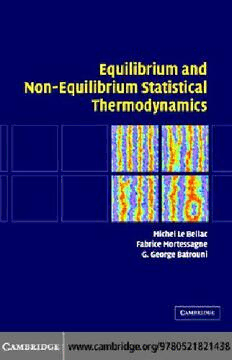
Equilibrium and Non-Equilibrium Statistical Thermodynamics PDF
Preview Equilibrium and Non-Equilibrium Statistical Thermodynamics
This page intentionally left blank EQUILIBRIUM AND NON-EQUILIBRIUM STATISTICAL THERMODYNAMICS This book gives a self-contained exposition at graduate level of topics that are generallyconsideredfundamentalinmodernequilibriumandnon-equilibriumsta- tisticalthermodynamics. The text follows a balanced approach between the macroscopic (thermody- namic)andmicroscopic(statistical)pointsofview.Thefirsthalfofthebookdeals with equilibrium thermodynamics and statistical mechanics. In addition to stan- dard subjects, such as the canonical and grand canonical ensembles and quantum statistics, the reader will find a detailed account of broken symmetries, critical phenomena and the renormalization group, as well as an introduction to numer- ical methods, with a discussion of the main Monte Carlo algorithms illustrated bynumerousproblems.Thesecondhalfofthebookisdevotedtonon-equilibrium phenomena,firstfollowingamacroscopicapproach,withhydrodynamicsasanim- portantexample.Kinetictheoryreceivesathoroughtreatmentthroughtheanalysis of the Boltzmann–Lorentz model and of the Boltzmann equation. The book con- cludes with general non-equilibrium methods such as linear response, projection methodandtheLangevinandFokker–Planckequations,includingnumericalsim- ulations.Onenotablefeatureofthebookisthelargenumberofproblems.Simple applications are given in 71 exercises, while the student will find more elaborate challengesin47problems,someofwhichmaybeusedasmini-projects. Thisadvancedtextbookwillbeofinteresttograduatestudentsandresearchers inphysics. MICHEL LE BELLAC graduated from the Ecole Normale Supe´rieure and ob- tainedaPh.D.inPhysicsattheUniversite´ Paris-Orsayin1965.Hewasappointed Professor of Physics in Nice in 1967. He also spent three years at the Theory Di- visionatCERN.Hehascontributedtovariousaspectsofthetheoryofelementary particlesandrecentlyhasbeenworkingonthetheoryofthequark–gluonplasma. HehaswrittenseveraltextbooksinEnglishandinFrench. FABRICE MORTESSAGNE obtained a Ph.D. in high-energy physics at the Universite´ Denis Diderot of Paris in 1995, and then was appointed Maˆıtre de Confe´rences at the Universite´ de Nice–Sophia Antipolis. He has developed semi- classical approximations of wave propagation in chaotic systems and was one of the initiators of the ‘Wave Propagation in Complex Media’ research group. In 1998 he extended his theoretical research activities with wave chaos experiments inchaoticopticalfibresandmicrowavebilliards. G. GEORGE BATROUNI obtained a Ph.D. in theoretical particle physics at the University of California at Berkeley in 1983 and then took a postdoctoral fel- lowship at Cornell University. In 1986 he joined Boston University and later the Lawrence Livermore National Laboratory. He became professor at the Universite´ deNice–SophiaAntipolisin1996.HewasawardedtheOnsagerMedalin2004by theNorwegianUniversityofScienceandTechnology.Hehasmadeimportantcon- tributions in the development of numerical simulation methods for quantum field theories and many body problems, and in the study of quantum phase transitions andmesoscopicmodelsoffracture. EQUILIBRIUM AND NON-EQUILIBRIUM STATISTICAL THERMODYNAMICS MICHEL LE BELLAC, FABRICE MORTESSAGNE AND G. GEORGE BATROUNI cambridge university press Cambridge, New York, Melbourne, Madrid, Cape Town, Singapore, São Paulo Cambridge University Press The Edinburgh Building, Cambridge cb2 2ru, UK Published in the United States of America by Cambridge University Press, New York www.cambridge.org Information on this title: www.cambridge.org/9780521821438 © M. Le Bellac, F. Mortessagne and G. G. Batrouni 2004 This publication is in copyright. Subject to statutory exception and to the provision of relevant collective licensing agreements, no reproduction of any part may take place without the written permission of Cambridge University Press. First published in print format 2004 isbn-13 978-0-511-19444-3 eBook (EBL) isbn-10 0-511-19444-7 eBook (EBL) isbn-13 978-0-521-82143-8 hardback isbn-10 0-521-82143-6 hardback Cambridge University Press has no responsibility for the persistence or accuracy of urls for external or third-party internet websites referred to in this publication, and does not guarantee that any content on such websites is, or will remain, accurate or appropriate. Contents Preface pagexv 1 Thermostatics 1 1.1 Thermodynamicequilibrium 1 1.1.1 Microscopicandmacroscopicdescriptions 1 1.1.2 Walls 3 1.1.3 Work,heat,internalenergy 5 1.1.4 Definitionofthermalequilibrium 8 1.2 Postulateofmaximumentropy 9 1.2.1 Internalconstraints 9 1.2.2 Principleofmaximumentropy 10 1.2.3 Intensivevariables:temperature,pressure,chemicalpotential 12 1.2.4 Quasi-staticandreversibleprocesses 17 1.2.5 Maximumworkandheatengines 20 1.3 Thermodynamicpotentials 22 1.3.1 ThermodynamicpotentialsandMassieufunctions 22 1.3.2 Specificheats 24 1.3.3 Gibbs–Duhemrelation 26 1.4 Stabilityconditions 27 1.4.1 Concavityofentropyandconvexityofenergy 27 1.4.2 Stabilityconditionsandtheirconsequences 28 1.5 Thirdlawofthermodynamics 31 1.5.1 Statementofthethirdlaw 31 1.5.2 Applicationtometastablestates 32 1.5.3 Lowtemperaturebehaviourofspecificheats 33 1.6 Exercises 35 1.6.1 Massieufunctions 35 1.6.2 Internalvariableinequilibrium 35 1.6.3 Relationsbetweenthermodynamiccoefficients 36 v vi Contents 1.6.4 Contactbetweentwosystems 37 1.6.5 Stabilityconditions 37 1.6.6 Equationofstateforafluid 37 1.7 Problems 38 1.7.1 Reversibleandirreversiblefreeexpansionsofanideal gas 38 1.7.2 vanderWaalsequationofstate 39 1.7.3 Equationofstateforasolid 40 1.7.4 Specificheatsofarod 41 1.7.5 Surfacetensionofasoapfilm 42 1.7.6 Joule–Thomsonprocess 43 1.7.7 Adiabaticdemagnetizationofaparamagneticsalt 43 1.8 Furtherreading 45 2 StatisticalentropyandBoltzmanndistribution 47 2.1 Quantumdescription 47 2.1.1 Timeevolutioninquantummechanics 47 2.1.2 Thedensityoperatorsandtheirtimeevolution 49 2.1.3 Quantumphasespace 51 2.1.4 (P,V,E)relationforamono-atomicidealgas 53 2.2 Classicaldescription 55 2.2.1 Liouville’stheorem 55 2.2.2 Densityinphasespace 56 2.3 Statisticalentropy 59 2.3.1 Entropyofaprobabilitydistribution 59 2.3.2 Statisticalentropyofamixedquantumstate 60 2.3.3 Timeevolutionofthestatisticalentropy 63 2.4 Boltzmanndistribution 64 2.4.1 Postulateofmaximumofstatisticalentropy 64 2.4.2 Equilibriumdistribution 65 2.4.3 Legendretransformation 67 2.4.4 Canonicalandgrandcanonicalensembles 68 2.5 Thermodynamicsrevisited 70 2.5.1 Heatandwork:firstlaw 70 2.5.2 Entropyandtemperature:secondlaw 72 2.5.3 Entropyofmixing 74 2.5.4 Pressureandchemicalpotential 77 2.6 Irreversibilityandthegrowthofentropy 79 2.6.1 Microscopicreversibilityandmacroscopicirreversibility 79 2.6.2 Physicalbasisofirreversibility 81 2.6.3 Lossofinformationandthegrowthofentropy 83 Contents vii 2.7 Exercises 86 2.7.1 Densityoperatorforspin-1/2 86 2.7.2 Densityofstatesandthedimensionofspace 88 2.7.3 Liouvilletheoremandcontinuityequation 88 2.7.4 Loadeddiceandstatisticalentropy 89 2.7.5 Entropyofacompositesystem 89 2.7.6 Heatexchangesbetweensystemandreservoir 89 2.7.7 Galileantransformation 90 2.7.8 Fluctuation-responsetheorem 90 2.7.9 PhasespacevolumeforNfreeparticles 92 2.7.10 Entropyofmixingandosmoticpressure 92 2.8 Furtherreading 93 3 Canonicalandgrandcanonicalensembles:applications 95 3.1 Simpleexamplesinthecanonicalensemble 95 3.1.1 Meanvaluesandfluctuations 95 3.1.2 Partitionfunctionandthermodynamicsofanidealgas 98 3.1.3 Paramagnetism 101 3.1.4 FerromagnetismandtheIsingmodel 105 3.1.5 Thermodynamiclimit 112 3.2 Classicalstatisticalmechanics 115 3.2.1 Classicallimit 115 3.2.2 Maxwelldistribution 116 3.2.3 Equipartitiontheorem 119 3.2.4 Specificheatofadiatomicidealgas 121 3.3 Quantumoscillatorsandrotators 122 3.3.1 Qualitativediscussion 122 3.3.2 Partitionfunctionofadiatomicmolecule 125 3.4 Fromidealgasestoliquids 127 3.4.1 Paircorrelationfunction 129 3.4.2 Measurementofthepaircorrelationfunction 132 3.4.3 Pressureandenergy 134 3.5 Chemicalpotential 136 3.5.1 Basicformulae 136 3.5.2 Coexistenceofphases 137 3.5.3 Equilibriumconditionatconstantpressure 138 3.5.4 Equilibriumandstabilityconditionsatconstantµ 140 3.5.5 Chemicalreactions 142 3.6 Grandcanonicalensemble 146 3.6.1 Grandpartitionfunction 146 3.6.2 Mono-atomicidealgas 149 viii Contents 3.6.3 Thermodynamicsandfluctuations 150 3.7 Exercises 152 3.7.1 Densityofstates 152 3.7.2 EquationofstatefortheEinsteinmodelofasolid 152 3.7.3 Specificheatofaferromagneticcrystal 153 3.7.4 Nuclearspecificheatofametal 153 3.7.5 Solidandliquidvapourpressures 154 3.7.6 Electrontrappinginasolid 155 3.8 Problems 156 3.8.1 One-dimensionalIsingmodel 156 3.8.2 Negativetemperatures 158 3.8.3 Diatomicmolecules 160 3.8.4 Modelsofaboundarysurface 161 3.8.5 Debye–Hu¨ckelapproximation 165 3.8.6 Thinmetallicfilm 166 3.8.7 Beyondtheidealgas:firsttermofvirialexpansion 168 3.8.8 Theoryofnucleation 171 3.9 Furtherreading 173 4 Criticalphenomena 175 4.1 Isingmodelrevisited 177 4.1.1 SomeexactresultsfortheIsingmodel 177 4.1.2 Correlationfunctions 184 4.1.3 Brokensymmetry 188 4.1.4 Criticalexponents 192 4.2 Meanfieldtheory 194 4.2.1 Aconvexityinequality 194 4.2.2 Fundamentalequationofmeanfieldtheory 195 4.2.3 Brokensymmetryandcriticalexponents 198 4.3 Landau’stheory 203 4.3.1 Landaufunctional 203 4.3.2 Brokencontinuoussymmetry 207 4.3.3 Ginzburg–LandauHamiltonian 210 4.3.4 BeyondLandau’stheory 212 4.3.5 Ginzburgcriterion 214 4.4 Renormalizationgroup:generaltheory 217 4.4.1 Spinblocks 217 4.4.2 Criticalexponentsandscalingtransformations 223 4.4.3 Criticalmanifoldandfixedpoints 227 4.4.4 Limitdistributionsandcorrelationfunctions 233
